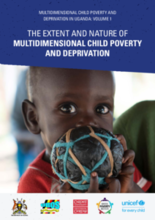Child poverty hampers children’s development, educational outcomes, job prospects, health and behaviour, often resulting in the chronic intergenerational transmission of poverty. In this respect, with close to 57% of the Ugandan population below 18 years of age, and over 78% below the age of 35 years, the country's vision of becoming a middle-income country by 2040 remains highly contingent on Government’s ability to safeguard children’s right to contribute to national development. A healthy, educated and empowered young population will enable Uganda to reap an unprecedented demographic dividend.
This report represents the successful integration of multidimensional child poverty measures in national statistics. In doing so it provides a better understanding of child poverty in Uganda by augmenting Uganda’s rich tradition of poverty analysis with a more deprivation-centred analytical tool.
Capitalising on this methodological innovation, reflected in the quantitative and qualitative analysis presented in Volumes 1 and 2, an additional objective of this analysis is to support Government’s efforts to transition from child poverty measurement to action by identifying specific areas of deprivation suffered by children to strengthen the delivery of basic services, and ultimately improve the implementation of national programmes affecting children.

